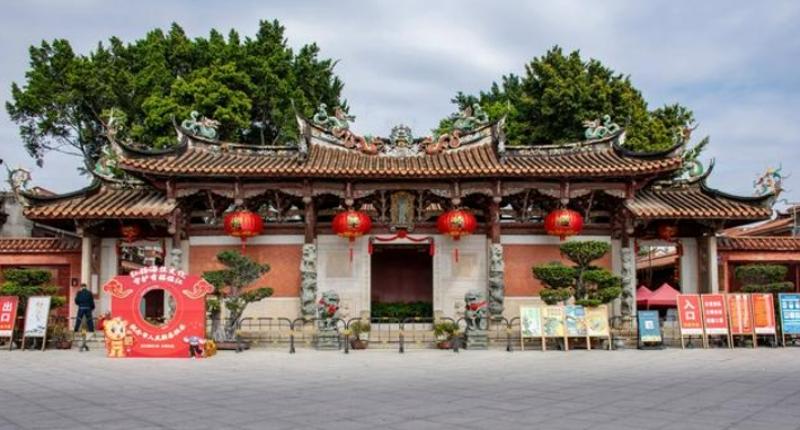Historical Background of Tianjin Ancient Culture Street
Tianjin Ancient Culture Street is a street composed of shops designed in the style of small Chinese Qing Dynasty buildings. It attracts countless visitors with its rich historical and cultural atmosphere. The center of Ancient Culture Street is the Tianhou Palace, an ancient relic from the Yuan Dynasty, commonly known as the "Empress Palace." This is the main attraction on the street. Here, not only is the history and culture of Tianjin showcased, but many traditional folk arts and crafts are also preserved.

Reference:Overview of Tianjin Ancient Culture Street
Historical Background of Tianhou Palace
Tianhou Palace, originally named Tianfei Palace and later renamed Tianhou Palace, is an ancient temple with a history of several hundred years. Tianjin, located east of the Bohai Sea and backing onto the capital, has been a hub of water and land transportation since ancient times. With the great development of canal transport, a temple was established to worship the sea goddess Tianhou to protect the canal transportation. The establishment of Tianhou Palace is closely related to the development of Tianjin’s canal transportation and served as a spiritual support for the shipping industry of the time.
Architectural Style of Tianhou Palace
Tianhou Palace is a typical ancient Chinese religious building with strong local characteristics. The architectural style of the temple incorporates the traditional architectural art of Tianjin, forming a unique aesthetic. The temple's painted beams, carved rafters, and colorful murals all showcase exquisite craftsmanship and rich cultural connotations.
Development of Ancient Culture Street
Ancient Culture Street was officially completed and opened on New Year's Day in 1986. Historically, this area has been Tianjin's largest market for trade and New Year goods. Every spring, the grand imperial festival celebrating the Empress's birthday was held here, featuring performances such as stilt walking, dragon lantern dances, land boats, and lion dances, creating a lively atmosphere. Today, Ancient Culture Street is not only a commercial center but also a place for cultural display and exchange.
Architectural Features of Ancient Culture Street
Except for the archways at both ends and the theater building in front of the palace, which are designed in the grand Qing Dynasty style, nearly one hundred houses on Ancient Culture Street are modeled after small Qing Dynasty folk buildings. The shopfronts on both sides of the street are exquisitely designed. Many of the eaves and beams have paintings with the artistic style of Jiangnan garden art. These paintings are vivid and typical, creating a brilliant and charming street scene.
Brick and Wood Carving Decorations
In addition to the painted story scenes, the brick and wood carvings are also a significant feature of the shopfront decorations. These carvings cover a wide range of subjects, most of which have a strong folk flavor and auspicious meanings. The wooden carvings in front of the Shibao Zhai store take inspiration from scenes in "Along the River During the Qingming Festival," depicting bustling ancient street life. The central scene of the carvings is the Rainbow Bridge outside the East Water Gate on the Bian River. The bridge is crowded with vehicles, livestock, various pedestrians, and people watching the river and boats, creating a lively urban scene, which is the climax of the "Along the River During the Qingming Festival" scroll.
Commercial Atmosphere of Ancient Culture Street
The architectural style, shop decorations, signboards, and couplets of Ancient Culture Street all carry a strong artistic atmosphere. Strolling along the street is a visual delight. Professional shops selling antiques, calligraphy, painting, four treasures of study, rubbings, ancient books, Yangliuqing New Year pictures, Clay Figurine Zhang sculptures, and Tianjin kites are gathered here, providing tourists with items to admire and purchase. Specialty stores for Western and Chinese musical instruments, art ceramics, and decorative items are also present, allowing visitors to find desired souvenirs while experiencing a rich cultural atmosphere.
Combination of Culture and Tourism
Ancient Culture Street is not only a great place for shopping but also a place for cultural immersion and inspiration. It attracts many tourists each year who can buy unique handicrafts and experience Tianjin's profound cultural heritage and historical atmosphere. Spending time here allows visitors to purchase favorite souvenirs and gain cultural insights and spiritual nourishment.
Since its opening on New Year's Day in 1986, Tianjin Ancient Culture Street has become a famous cultural and tourist destination in Tianjin and across China. Both local residents and visitors from afar can find their own cultural memories and wonderful experiences here.
Questions and Answers
Q1: What is the historical significance of Tianhou Palace in Tianjin Ancient Culture Street?
A1: Tianhou Palace, originally known as Tianfei Palace, is a centuries-old temple established to worship the sea goddess Tianhou, aiming to protect canal transportation. Its establishment is closely tied to the development of Tianjin's canal transportation and serves as a spiritual support for the shipping industry of that time.
Q2: What can visitors expect to find on Tianjin Ancient Culture Street in terms of cultural and commercial offerings?
A2: Visitors to Tianjin Ancient Culture Street can enjoy a blend of cultural and commercial offerings, including professional shops selling antiques, calligraphy, paintings, traditional Chinese handicrafts, and souvenirs. The street is also known for its artistic decorations, such as painted story scenes and intricate brick and wood carvings, which provide a rich cultural atmosphere and a visually delightful experience.